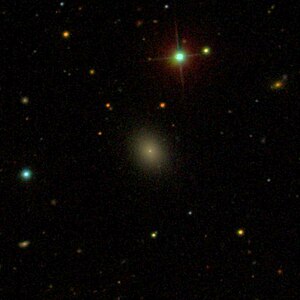IC 3101
| Galaxy IC 3101 |
|
|---|---|

|
|
| AladinLite | |
| Constellation | Virgin |
|
Position equinox : J2000.0 , epoch : J2000.0 |
|
| Right ascension | 12 h 17 m 19.6 s |
| declination | + 11 ° 56 ′ 36 ″ |
| Appearance | |
| Morphological type | dE4:, N: |
| Brightness (visual) | 14.3 mag |
| Brightness (B-band) | 15.3 mag |
| Angular expansion | 0.6 ′ × 0.4 ′ |
| Position angle | 20 ° |
| Surface brightness | 12.8 mag / arcmin² |
| Physical data | |
| Affiliation | Virgo cluster |
| Redshift | 0.004767 ± 0.000067 |
| Radial velocity | 1429 ± 20 km / s |
|
Stroke distance v rad / H 0 |
(61 ± 4) · 10 6 ly (18.7 ± 1.3) Mpc |
| history | |
| discovery | Royal H. Frost |
| Discovery date | May 7, 1904 |
| Catalog names | |
| IC 3101 • PGC 39405 • CGCG 069-128 • 2MASX J12171966 + 1156369 • VCC 230 • GALEX ASC J121719.58 + 115635.3 • EVCC 275 | |
IC 3101 is a faint , elliptical dwarf galaxy of the Hubble type dE4 in the constellation Virgo on the ecliptic . It is an estimated 61 million light years away from the Milky Way and has a diameter of around 10,000 ly. Under the catalog name VCC 230 , it is listed as a member of the Virgo galaxy cluster .
The galaxies IC 3100 , IC 3105 , IC 3127 , IC 3128 are located in the same area of the sky .
The object was discovered by Royal Harwood Frost on May 7, 1904 .
